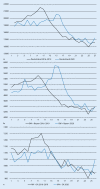[SARS-CoV-2/COVID-19-epidemiology and prevention]
- PMID: 33343742
- PMCID: PMC7736674
- DOI: 10.1007/s11560-020-00472-0
[SARS-CoV-2/COVID-19-epidemiology and prevention]
Abstract
Severe acute respiratory syndrome coronavirus 2 (SARS-CoV-2) has rapidly spread globally since December 2019. A first wave is visible up to the end of June 2020 in many regions. This article presents a review of the current knowledge on the epidemiology and prevention. The SARS-CoV‑2 predominantly replicates in the upper and lower respiratory tracts and is particularly transmitted by droplets and aerosols. The estimate for the basic reproduction number (R0) is between 2 and 3 and the median incubation period is 6 days (range 2-14 days). As with the related SARS-CoV and Middle East respiratory syndrome (MERS-CoV), superspreading events play an important role in the dissemination. A high proportion of infections are uncomplicated but moderate or severe courses develop in 5-10% of infected persons. Pneumonia, cardiac involvement and thromboembolisms are the most frequent manifestations leading to hospitalization. Risk factors for a complicated course are high age, hypertension, diabetes mellitus and chronic cardiovascular and pulmonary diseases as well as immunodeficiency. Currently, the estimation for the infection fatality rate (IFR) is between 0.5% and 1% across all age groups. Outbreaks were limited in many regions with bundles of various measures for reduction of social contacts. The incidence for the first wave in Germany can be estimated as 0.4-1.8% and excess mortality could not be observed.
SARS-CoV‑2 („severe acute respiratory syndrome coronavirus 2“) hat sich seit Dezember 2019 rasch weltweit ausgebreitet. Eine erste Welle ist bis Ende Juni 2020 in vielen Regionen sichtbar. Wir stellen hier das aktuelle Wissen zur Epidemiologie und Prävention dar. SARS-CoV‑2 wird v. a. durch Tröpfchen und Aerosole übertragen und repliziert überwiegend im oberen und unteren Respirationstrakt. Die Basisreproduktionszahl R0 liegt zwischen 2 und 3, die Inkubationszeit beträgt im Median 6 (2–14) Tage. Wie bei den verwandten Coronaviren SARS-CoV und MERS(„Middle East respiratory syndrome“)-CoV spielen Superspreading-Ereignisse bei der Ausbreitung eine wichtige Rolle. Eine hohe Rate von Infektionen verläuft unkompliziert, moderate bis schwere Verläufe treten bei 5–10 % der Infizierten auf. Pneumonien, kardiale Beteiligung und Thromboembolien sind die häufigsten zur Hospitalisierung führenden Manifestationen. Risikofaktoren für einen komplizierten Verlauf sind höheres Alter, Hypertonie, Diabetes mellitus und chronische Herz- und Lungenerkrankungen sowie Immundefekte. Derzeit liegt die Schätzung für die IFR („infection fatality rate“) über alle Altersgruppen zwischen 0,5 und 1 %. Mit Bündeln verschiedener Maßnahmen zur Reduktion sozialer Kontakte wurden Ausbrüche in vielen Regionen begrenzt. Für Deutschland wird für die erste Welle eine Befallsrate von 0,4–1,8 % geschätzt, eine Übersterblichkeit konnte dabei nicht beobachtet werden.
Keywords: Basic reproduction number; Coronavirus; Infection fatality rate; Mortality; Pandemic.
© Springer Medizin Verlag GmbH, ein Teil von Springer Nature 2020.
Similar articles
-
[Epidemiology of SARS-CoV-2/COVID-19].Gastroenterologe. 2020;15(6):443-451. doi: 10.1007/s11377-020-00479-y. Epub 2020 Oct 29. Gastroenterologe. 2020. PMID: 33144889 Free PMC article. Review. German.
-
Epidemiology of SARS-CoV-2.Infection. 2021 Apr;49(2):233-239. doi: 10.1007/s15010-020-01531-3. Epub 2020 Oct 8. Infection. 2021. PMID: 33034020 Free PMC article. Review.
-
[Epidemiology of SARS-CoV-2 infection and COVID-19].Internist (Berl). 2020 Aug;61(8):782-788. doi: 10.1007/s00108-020-00834-9. Internist (Berl). 2020. PMID: 32548652 Free PMC article. Review. German.
-
Testing the efficacy and safety of BIO101, for the prevention of respiratory deterioration, in patients with COVID-19 pneumonia (COVA study): a structured summary of a study protocol for a randomised controlled trial.Trials. 2021 Jan 11;22(1):42. doi: 10.1186/s13063-020-04998-5. Trials. 2021. PMID: 33430924 Free PMC article.
-
SEVERE ACUTE RESPIRATORY SYNDROME CORONAVIRUS-2 (SARS-COV-2) INFECTION: AN EPIDEMIOLOGICAL REVIEW.Ann Ib Postgrad Med. 2021 Jun;19(Suppl 1):S68-S76. Ann Ib Postgrad Med. 2021. PMID: 35095373 Free PMC article.
Cited by
-
Post-COVID syndrome in non-hospitalised patients with COVID-19: a longitudinal prospective cohort study.Lancet Reg Health Eur. 2021 Jul;6:100122. doi: 10.1016/j.lanepe.2021.100122. Epub 2021 May 18. Lancet Reg Health Eur. 2021. PMID: 34027514 Free PMC article.
-
The Adaptive Force as a Potential Biomechanical Parameter in the Recovery Process of Patients with Long COVID.Diagnostics (Basel). 2023 Feb 25;13(5):882. doi: 10.3390/diagnostics13050882. Diagnostics (Basel). 2023. PMID: 36900026 Free PMC article.
-
Prediction of cross-border spread of the COVID-19 pandemic: A predictive model for imported cases outside China.PLoS One. 2024 Apr 9;19(4):e0301420. doi: 10.1371/journal.pone.0301420. eCollection 2024. PLoS One. 2024. PMID: 38593140 Free PMC article.
-
Agent-based modeling to estimate the impact of lockdown scenarios and events on a pandemic exemplified on SARS-CoV-2.Sci Rep. 2024 Jun 11;14(1):13391. doi: 10.1038/s41598-024-63795-1. Sci Rep. 2024. PMID: 38862580 Free PMC article.
References
-
- Destatis . Sterbefälle – Fallzahlen nach Tagen, Wochen, Monaten, Altersgruppen und Bundesländern für Deutschland 2016–2020. Berlin: DeStatis; 2020.
Publication types
LinkOut - more resources
Full Text Sources
Research Materials
Miscellaneous



